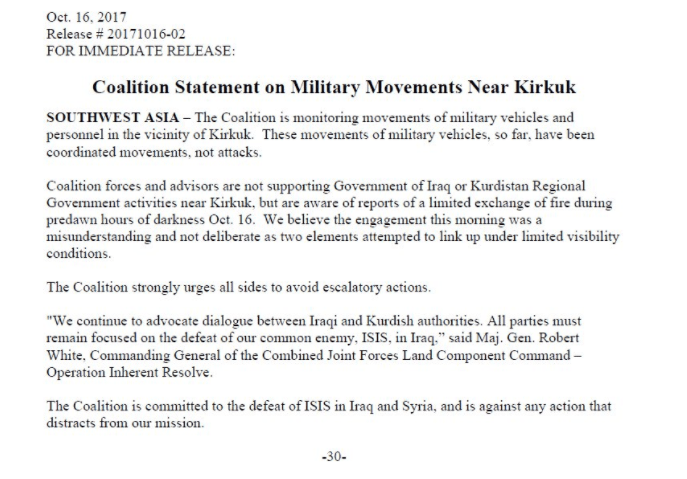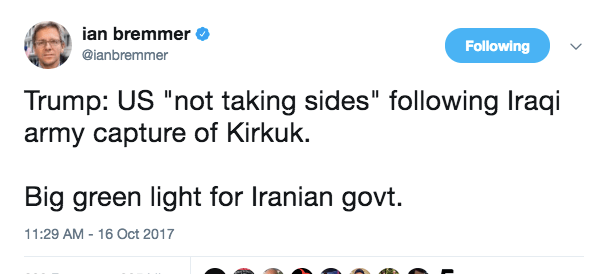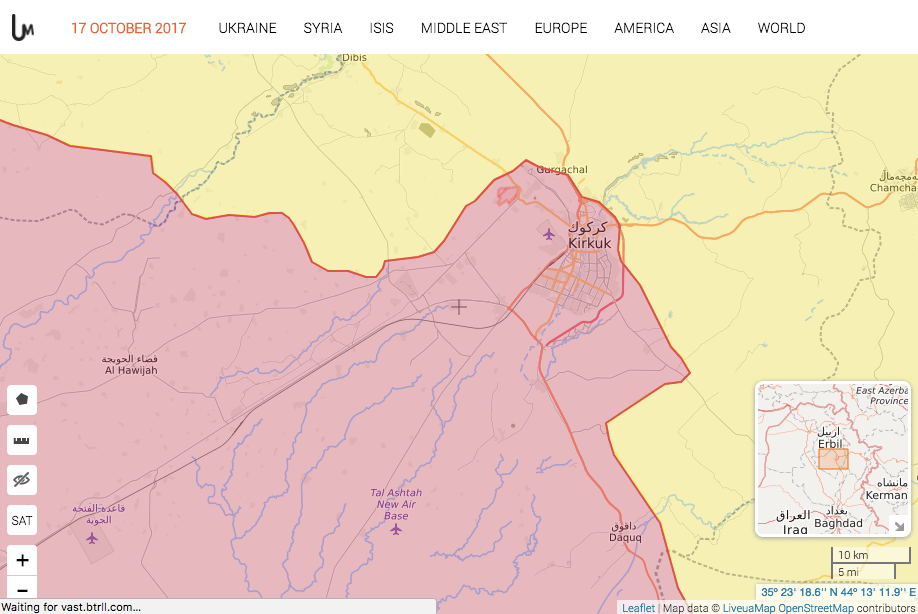By Seth J. Frantzman
The rapid and unprecedented fall of Kirkuk on October 16, 2017 will likely be remembered as a turning point in Kurdish history and perhaps Iraq’s history. It reversed years of the Kurdistan Regional Government’s achievements. It resulted in the loss of oil fields and strategic areas for the Kurdish autonomous region. It resulted also in the reduction in status of a major city that Kurds have fought for with Baghdad over decades. It set back the autonomous region’s attempts in 2017 to assert more control, including flying the Kurdish flag from government institutions and including the city in the independence referendum on September 25. Kirkuk had come under total KRG control when the Iraqi army collapsed and fled in 2014 as Islamic State attacked. Now the Kurdish Peshmerga have collapsed and fled in the face of a powerful Iraqi army and its Shia militia or Hashd al-Shaabi Popular Mobilization Units. The Iraqi central government sent all their best US-trained and US-equipped units to take Kirkuk including the ISOF and Iraqi armored columns, Federal police and ERD.
Despite boasts that locals would fight for the city on the night of October 14 and 15, the city fell without almost a shot being fired. There were dozens of casualties in a few crises, but for a city of at least 1 million people to be captured in less than 12 hours, it was unprecedented.
What led to the collapse? The full story may never be known, but there are many indications that can be examined through asking the right questions.
Kurds on social media have said that days before the offensive the Quds Force commander Qasim Soleimani “told the PUK to give oil fields back and cancel referendum (@oremar11).” Allegedly Lawk Ghafuri writes a deal was presented whereby the Sulaymaniyah airport would be opened and salaries paid. Shwan Zulal writes “one picture emerging in Kirkuk, KDP wanted PUK to fight and PUK wanted the KDP to fight, neither was willing and a deal was made.” Tobias Schneider writes “so Talabani-PUK struck a deal, Kosrat-PUK appears blindsided, KDP screaming….PKK getting some PR.” Rumors have spread that other disputed areas could be affected such as Makhmour, and even Gwer and Sinjar.
Nibras Kazimi asks if this will politically damage the Barzani and Talabani families who hold influence. There has been discussion of a national unity style government but the reality after Kirkuk appears to show the KDP and PUK more divided than in the last two decades. Kazimi notes that the agreement to give up Kirkuk was made after Mam Jalal’s funeral on October 6, “between Bafel Talabani and Abu Mahdis al-Muhandis.” Soleimani put the final touches on it at Dukan just a day before the offensive. “My analysis: Brits want to safeguard Abadi’s second term by making him useful to Soleimani.” This argument reveals that the public presence of Abu Mahdi al-Muhandis and Hadi al-Amiri in Kirkuk on October 16th lowering the Kurdish flag was not originally agreed upon with Western powers. “This was handled at low levels (McGurk, war theater generals),” because US has given up on real politics, stability and peace negotiation in Iraq. It tried that from 2003 to 2011, when it returned in 2014 it was solely as “advise and assist” or as it calls it “by, with and through.” This has jettisoned Kurds and Sunni Arabs in Iraq, centralizing power in Iran’s hands in Baghdad.
US statements during the crises were bizarre. Brett McGurk and coalition leaders stopped tweeting. When the embassy in Baghdad finally had a statement, it was merely “concerned,” it didn’t acknowledge the gravity of the situation. Similarly the coalition finally did mention the crises but said the clashes were a misunderstanding. Both Baghdad and the coalition spoke of “coordination” and Baghdad mentioned “planning.”

What did the US know and when did they know it? The coalition claimed that clashes were just a “misunderstanding.” When Maj Gen Pat White, commanding general of CJFLCC-OIR, tweeted on October 12 that he had no evidence of threats from Baghdad, the OIR spokesman followed this up with claims that movements of armored columns was “natural.”
The assertion that the US knew the Iraqis were massing forces makes sense since they could not have missed it. The US had advisors with these units such as the 9th armored during the Hawija offensive. The question is who did the US talk to and which pieces of the US government were in touch with who. To what degree was the rapid fall of Kirkuk due to pressure from the US and an ultimatum. This leads to questions why US pressure didn’t prevent the referendum despite Secretary of State Rex Tillerson’s last minute attempt. The US promised that with the UN it would give “support for a one-year dialogue between the Kurds and the government of Baghdad to address a number of outstanding issues that have roiled that relationship in recent years. These include the status of the Kurdish militias known as the Peshmerga, agreements on civil aviation to the Kurdistan region, sharing national oil revenues, the status of the disputed city of Kirkuk and diplomatic representation of Barzani’s diplomats in foreign capitals.”
Now notice that the US felt its wishes were not heeded so now the punishment is to remove all the things that were part of the package, including Kirkuk, airports and there is evidence of Baghdad trying to take control of the Peshmerga. This would be a pretext for war with Erbil, which may be the ultimatum the US now wants, to dismantle the Erbil-led part of the KRG. This would leave an Iranian-dominated piece of the KRG in Sulaymaniyah, which the US and UK and others have preferred to work with. If this is true it is shocking. Before the October 16 offensive there were rumors on social media that the US had guaranteed the Kurds support if the Iraqis attacked Kirkuk. This may have been a delicate misinformation campaign, like the one claiming movement of armored columns, luring Kurds into a sense of complacency just before the jaws of the offensive snapped shut and it was too late. October 16 presented the KDP in Kirkuk and the resistance factions of the PUK such as Governor Najmaldin Karim and Vice-President Kosrat Rasol with a fait accompli. Such overwhelming force was used that they had to flee. Kurdish Peshmerga leaders such as Dr. Kemal Kirkuki who had said his men were ready to defend the areas near the city, were taken by surprise.
This would make sense if the US, Baghdad, and Iran had already concluded a deal with Sulaymaniyah. The US may not have been privy to every piece of the deal, such as the role of the Shia militias Asai’b Ahl al-Haq and Badr’s Turkmen units.

October 13: Peshmerga withdraw
What happened on October 13th? On October 13th PUK Peshmerga withdrew from area near Bashir village and Taza. A base was abandoned. This seems like a dry run for the total collapse on October 16th. The KRG sought to negotiate on October 14th after this small collapse. Iraqi President, who is Kurdist, Fuad Masum went to Sulaymaniyah on October 14 to discuss the situation. It’s unclear what he accomplished. A proposal was sent to Baghdad, but Baghdad’s ultimatum to hand over federal facilities continued.

The night of October 14: On October 14 the Kurdistan Regional Security Council tweeted “Iraqi forces have threatened to attack Peshmerga positions in South West of Kirkuk at midnight unless all forces stand down.” Earlier they had warned about the attack on oil fields, airport and military base, the exact objectives that materialized on October 16. This indicates that the Iraqi plan and the deal’s objectives were known, they just didn’t know the date. Perhaps Baghdad was not quite ready. On October 14th men gathered on the streets to defend Kirkuk. The same thing happened the night of the 15th. But on the night of the 15th the rumors were real.

This Prime Minister’s tweets indicate several important details. The desire to reclaim the 2014 situation is one aspect. Also the mentioning of “cooperate” with Peshmerga. Indications of prior planning and coordination were clear. October 14th had simply been postponed for 24 hours. The Iraqi government also raised the claim that the PKK were in in Kirkuk in order to add one more reason for the assault. It wanted Turkey on board since Turkmen are a major minority in the city. Iran was already on board and leading the way.

Abu Mahdi al-Muhandis and Hadi al-Amiri go to Kirkuk the day before: The day before the offensive the two senior PMU commanders headed to Kirkuk for discussions. What were they negotiating. The next day they would be in Kirkuk and it would be their city as they raised the Iraqi flag over it. So they were handing the Kurds a fait accompli, right? What was the point of the visit? To survey the city and make final details for its fall. Whatever agreement was made was inked once again. Qassem Soleimani visited the Kurdish region on the eve of the offensive. He was evidently finalizing the deal as well. Clearly Soleimani managed this offensive and in so doing it has the mark of Iran’s IRGC and Quds Force on it. This comes in the context of the US administration putting sanctions on the IRGC and seeking to decertify the Iran deal. However Baghdad had been threatening Kirkuk since September 28th. Soleimani felt that Baghdad did not have the initiative to put together a complex operation and deal, whereas Iran could because of its connections to parts of the PUK and its militias.

Kirkuk was abandoned without any attempt to withdraw in an orderly manner: If there was a deal why wasn’t the city handed over in a normal and orderly manner. Instead Kurdish forces fled. One Peshmerga wrote on Facebook “the peshmerga by far and large were not notified of the backdoor deal by some PUK. The deaths of peshmerga and any civilians lies solely on [those] who made a deal and left their men to die and gave little notice of the plan…We had 0 notice of pulling back. And we barely made it out as rocketfire came down. Also every PUK checkpoint we drove past was abandoned. There wasn’t a single person manning the checkpoints and this was far past Dibz as well.”
Whereas it took the Iraqi army 9 months to take Mosul, it took 9 hours to take Kirkuk. No barricades were erected and all those who came onto the streets on the night of October 14 and 15 did not fight. The governor and others who had vowed that morale was high, did not stand. On October 16th Iraqi forces wandered into the abandoned governors office and others walked around the local council.
This indicated that there was never an intention to defend the city and there was likely no plan to defend it. The city could have resisted. No leaders wanted to defend it. This was not even a rout or debacle, it was completely abandoned. This represents a massive failure of leadership. The fact that there were secret deals and Peshmerga left their positions has spread rumormongering and left bitter recriminations in the Kurdish region. Obviously the Kurdish leadership that made the choice to leave Kirkuk thought that if they had told the citizens this might have led to a local coup in the city or mass demand to defend it. But doing it secretly appears like a betrayal. The question of who betrayed who is still being cast around by all sides. But this only emboldens and strengthens Baghdad and Iran. It makes the KRG seem incapable of behaving like a state, the very independence it seeks. The success of Baghdad at dividing the Kurdish leadership and taking such an important city, imposing its will more than Baghdad was able to do from 2003 to present, is a major achievement for Baghdad. Now Iraq’s authorities will be emboldened to do more. In addition those who made the deal will be entirely reliant on Iran.

An added affect is that the leadership in Erbil had relied on the US to do something. Not only did they think that showing the degree of Iranian IRGC involvement would convince Washington to stand by its friends in the KRG, they also believed the US would recall its close alliance with the Kurds over the decades. Shock greeted the fact that US President Donald Trump has said he will not take sides. Inevitably that means siding with the stronger power. Since the Iraqi army is US-trained and US-equipped and working with Iran’s IRGC, this means that the US is siding with Baghdad.
US equipment and US training and the fall of Kirkuk US training of the Iraqi army and the heavy weapons provided over the years to fight Islamic State played a role in the taking of Kirkuk. This is a strange irony, that the US trained and equipped the Iraqi army that was then used on Kurds in collaboration with Iranian-backed sectarian militias. The question of how much US equipment may have ended up in the hands of the militias or how deeply entwined they are with the army they are is a key question. The bifurcation the US would like to see does not exist when Badr runs the Interior Ministry which runs the Federal Police who participate in these operations with US equipment. The US may finally be realizing this is a problem but the message not to use US equipment against Kurdish allies should have been sent strongly before October 16th.
What’s left after Kirkuk has fallen?
The events of October 16th cast a shadow over Iraq. Although US Senators John McCain and Chuck Schumer have stepped forward to express concern about the lack of US support for Kurds, any moves from Washington may come too late. The US military is also hamstrung in Iraq, with its mission of defeating ISIS, it has scaled back training of the Kurds. McCain said on October 16: “I am especially concerned by media reports that Iranian and Iranian-backed forces are part of the assault. Iraqi forces must take immediate steps to de-escalate this volatile situation by ceasing their advances.” Despite Trump’s tough talk on Iran, the administration has not connected Kirkuk to its claims to want to confront Iran. This is because the US knows that if it acknowledges the presence of the PMU it will have to admit that the coalition has been working too closely with the PMU and that defeating ISIS has empowered the PMU without any strategy by the US to roll back the Iranian influence. The US has created a kind of golem in Baghdad. The more Baghdad is beholden to Iran, the more the US is beholden to Baghdad to try to beg it not to be close to Iran. Scuppering relations with Kurds might even be on the table for some forlorn hope that Iran’s influence can be checked.

The area conquered around Kirkuk (ISIS Live Map)
Focus now moves to Erbil and Sulaymaniyah The Kurdish leadership will have to shore up support in the wake of the Kirkuk catastrophe. ISIS will want to take advantage of the breakdown in security around Kirkuk. It is unclear how the KDP and PUK will work together after the controversy. It is also unclear how elections will take place in Iraq or the Kurdish region in the future. The US failure to try to broker some kind of a deal has made the US an unreliable partner and one that will be less trusted. Disinformation spread before the Iraqi attack that led people into false sense of security will now lead to more rumormongering.

Destruction of Kurdish signs after city falls (Rudaw tweet)
The Kirkuk crises was therefore aimed not just at taking over federal institutions around the city, but demoralizing the Kurdistan region and spreading division and infighting and weakening the KRG. The next step will be for Iraq and Iran to try to pry Sulaymaniyah away and perhaps to close the border. There may be more demands to see if there is a red line. It will be interesting to see if the central government does share power as the constitution calls for in Kirkuk. If PUK leaders are invited back and Kurdish flags are seen again and Kurdish posters blanketed over with Iraqi flags are uncovered than the triumphalism may be reduced and the sectarian and ethnic conflict might be reduced. However lines of people fleeing and rumors of Kurds killed or houses burned are not helping any kind of coexistence. One Baghdad has taken power it will not want to hand any of it back.
There will now be questions about the referendum and whether it was worth it. There will also be questions about whether the period 2013-2017 was a high point of autonomy. Did the KRG misread Baghdad and the US? How will it get back the power and freedoms it enjoyed in 2014-2016, with control over its airports and exports. Unless a western ally steps forward it is unclear how the unique stability the KRG built up over the years, including investment from all over the Middle East, can be built on. The KRG has immense potential and brought safety, diversity and wealth to the areas it governed. Kirkuk, once a dangerous city with many extremists, was a safe city under the Kurdish leadership. Refugees have fled to the Kurdish region for a reason. But now the question is where Erbil goes from here. Discussions about working with Russia and oil deals and the economy are important. But threats from Baghdad can destabilize the Kurdish region. Abadi got Kirkuk without any real casualties. He may not heed calls for negotiations now that he feels so powerful.
